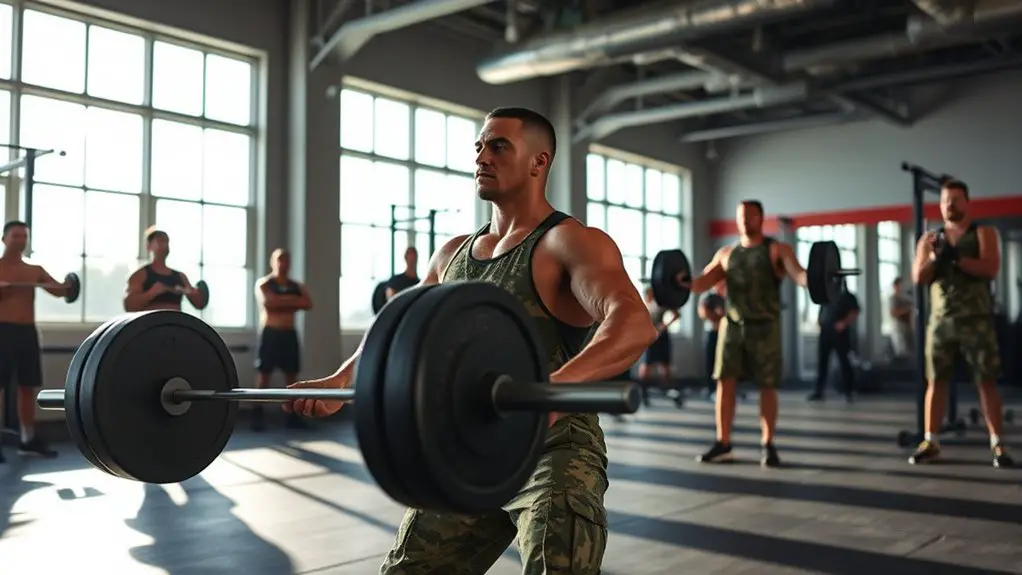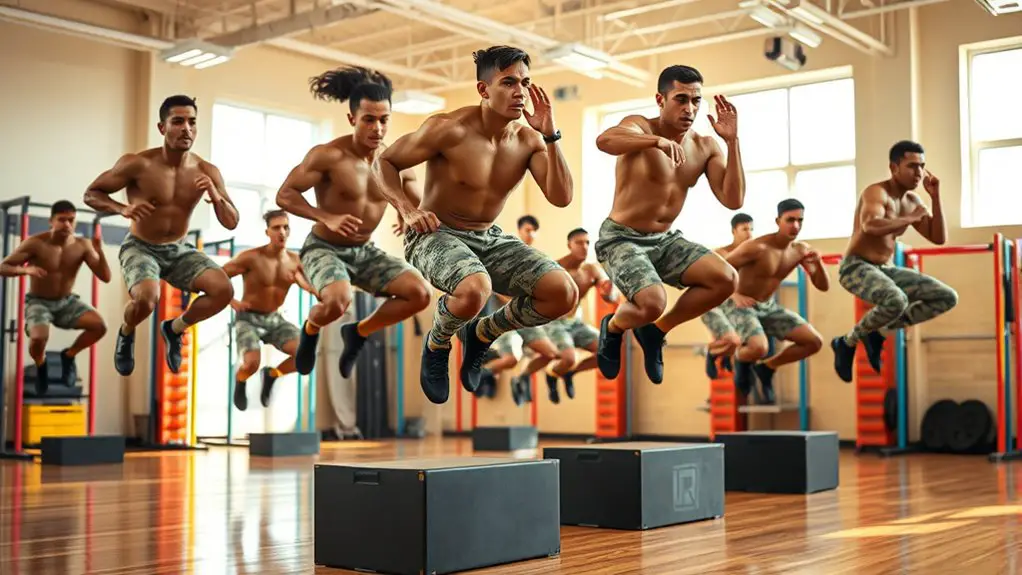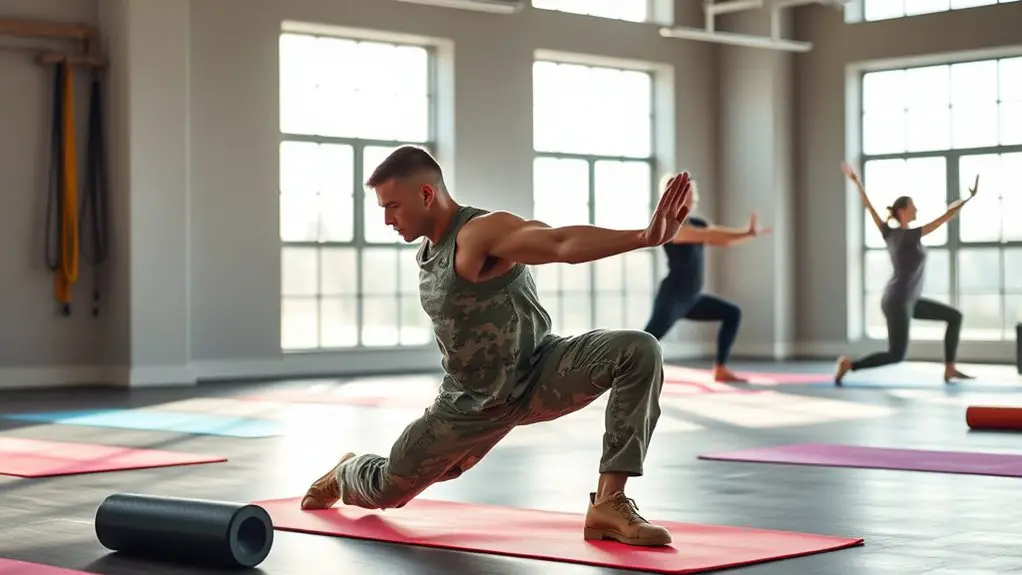The Best Gym Exercises for Military Personnel

To excel in military fitness, focus on compound movements like squats, deadlifts, and bench presses to build strength. Incorporate high-intensity interval training and steady-state cardio to boost endurance for long missions. Add plyometric exercises such as box jumps and burpees to improve agility and power. Don’t forget core exercises like planks and Russian twists to enhance stability. Finally, prioritize recovery with dynamic and static stretching to maintain flexibility. Explore effective routines to maximize your performance!
Enhancing Strength With Compound Movements

When it comes to building strength, compound movements are your best friend, as they engage multiple muscle groups simultaneously, making your workouts more efficient. Incorporating these exercises into your strength training routine not only enhances muscle growth but also improves functional fitness, essential for military personnel.
Think about movements like squats, deadlifts, and bench presses. They mimic real-life activities, helping you develop the strength needed for various tasks. By focusing on proper form and gradually increasing weight, you’ll build a solid foundation. The clean and press is an excellent example of a compound movement that engages multiple muscle groups and emphasizes proper technique.
Aim for a balanced routine that includes both upper and lower body compound exercises. This way, you’ll not only maximize your time in the gym but also enhance your overall performance. Remember, consistency is key; stick with it, and you’ll see significant gains. Compound movements are more than just exercises—they’re a pathway to becoming stronger and more capable in any situation.
Building Endurance Through Cardiovascular Training
While strength is crucial, building endurance through cardiovascular training is equally essential for military personnel. Enhancing your aerobic capacity guarantees you can perform at your best during long missions or intense physical activities. One effective method is interval training, where you alternate between high-intensity bursts and recovery periods. This approach not only boosts your stamina but also maximizes calorie burn.
Start by incorporating activities like running, cycling, or rowing into your routine. Aim for sessions that include both steady-state cardio and interval training to keep things dynamic and engaging. For instance, sprint for 30 seconds, then recover for a minute, repeating this cycle several times. Jump roping is another great option that provides an excellent cardiovascular workout, enhancing heart health.
Consistency is key; make cardiovascular training a regular part of your regimen. As you progress, you’ll find your endurance improves, enabling you to tackle more challenging tasks with ease. Remember, every step you take towards building endurance gets you closer to your goals.
Improving Agility With Plyometric Exercises

To enhance your agility, incorporating plyometric exercises into your training routine can be a game-changer. These exercises focus on jump training and explosive movements, which are vital for improving your speed and responsiveness. Start with box jumps to develop power and coordination. Aim for a series of quick jumps, shifting seamlessly from one to another.
Burpees are another great option; they combine strength and agility, pushing your limits with explosive movements. Don’t forget lateral bounds, which help improve your side-to-side agility, essential for tactical maneuvers.
Set aside dedicated time each week for plyometric workouts, ensuring you’re challenging yourself while maintaining proper form to prevent injuries. As you progress, you’ll notice quicker reaction times and enhanced overall performance in the field. Embrace these dynamic exercises, and watch your agility soar!
Core Stability for Tactical Performance
Core stability is essential for tactical performance, as it not only supports your movements but also enhances your overall strength and endurance. Building core strength is vital for achieving tactical readiness, allowing you to execute maneuvers effectively and safely. Here are key exercises to enhance your core stability:
| Exercise | Benefits |
|---|---|
| Planks | Increases endurance and strength in the core. |
| Russian Twists | Improves rotational strength and coordination. |
| Dead Bugs | Enhances stability and control during movement. |
| Mountain Climbers | Boosts cardiovascular fitness while engaging the core. |
| Medicine Ball Throws | Develops explosive power and core engagement. |
Incorporate these exercises into your routine, and you’ll notice improvements in agility, balance, and overall performance. Remember, a strong core is the foundation of tactical effectiveness, so prioritize these exercises to elevate your readiness.
Recovery and Flexibility: The Importance of Stretching

Recovery and flexibility play an essential role in your overall fitness and performance, especially in high-demand environments like military service. Incorporating both dynamic stretching and static stretching into your routine can greatly enhance your mobility and reduce the risk of injury.
Before your workouts, dynamic stretching is imperative. It warms up your muscles and prepares your body for intense movements, improving your range of motion and performance. Think leg swings, arm circles, or walking lunges to get your blood flowing.
After training, static stretching is just as important. It helps you cool down, enhances flexibility, and aids recovery by elongating your muscles. Focus on holding stretches for 15-30 seconds, targeting all major muscle groups to promote ideal recovery. Regular stretching increases flexibility and reduces injury risk, making it essential for maintaining overall physical health and well-being.
Frequently Asked Questions
How Often Should Military Personnel Work Out Each Week?
When it comes to workout frequency, you should aim for at least five days a week. This keeps your body conditioned and ready for any challenge. Adjust your training intensity based on your goals; mixing high-intensity workouts with lower-intensity recovery sessions can enhance your performance. Remember, consistency is key, so find a routine that fits your lifestyle and keeps you motivated. You’ve got the potential—it’s all about commitment and smart planning!
What Should I Eat Before and After Workouts?
Think of your body as a finely tuned machine; it needs the right fuel to perform at its best. For pre-workout nutrition, grab a light meal rich in carbs and protein—like a banana with peanut butter—to give you that energy boost. After your workout, focus on post-workout recovery with a protein shake or a chicken salad to replenish what you’ve lost. Keep this routine, and your body will thank you for it!
How Can I Prevent Injuries During Training?
To prevent injuries during training, focus on injury prevention strategies and proper training techniques. Always warm up and cool down, ensuring your muscles are prepared. Use correct form to minimize strain, and listen to your body—if something feels off, take a break. Gradually increase your intensity to avoid overexertion. Incorporating flexibility and strength exercises into your routine can also help build resilience and keep you in peak condition for training.
Are There Specific Exercises for Different Military Branches?
Imagine a tree, each branch strong yet unique, needing specific care to thrive. Just like that, each military branch requires branch-specific drills tailored to their missions. Whether it’s the Army’s rigorous fitness assessments or the Navy’s endurance challenges, these exercises guarantee you’re prepared. Embrace this diversity in training, and you’ll not only enhance your skills but also build a resilient foundation. Stay committed, and let your growth inspire those around you.
How Do I Track My Progress Effectively?
To track your progress effectively, start with progress journaling. Document your workouts, noting performance metrics like reps, sets, and weights. This’ll help you identify patterns and areas for improvement. Set specific, measurable goals to keep you motivated, and review your journal regularly to celebrate achievements. Don’t forget to adjust your routine based on your progress; staying flexible is key to continued growth. Remember, consistency is essential for reaching your fitness objectives!





